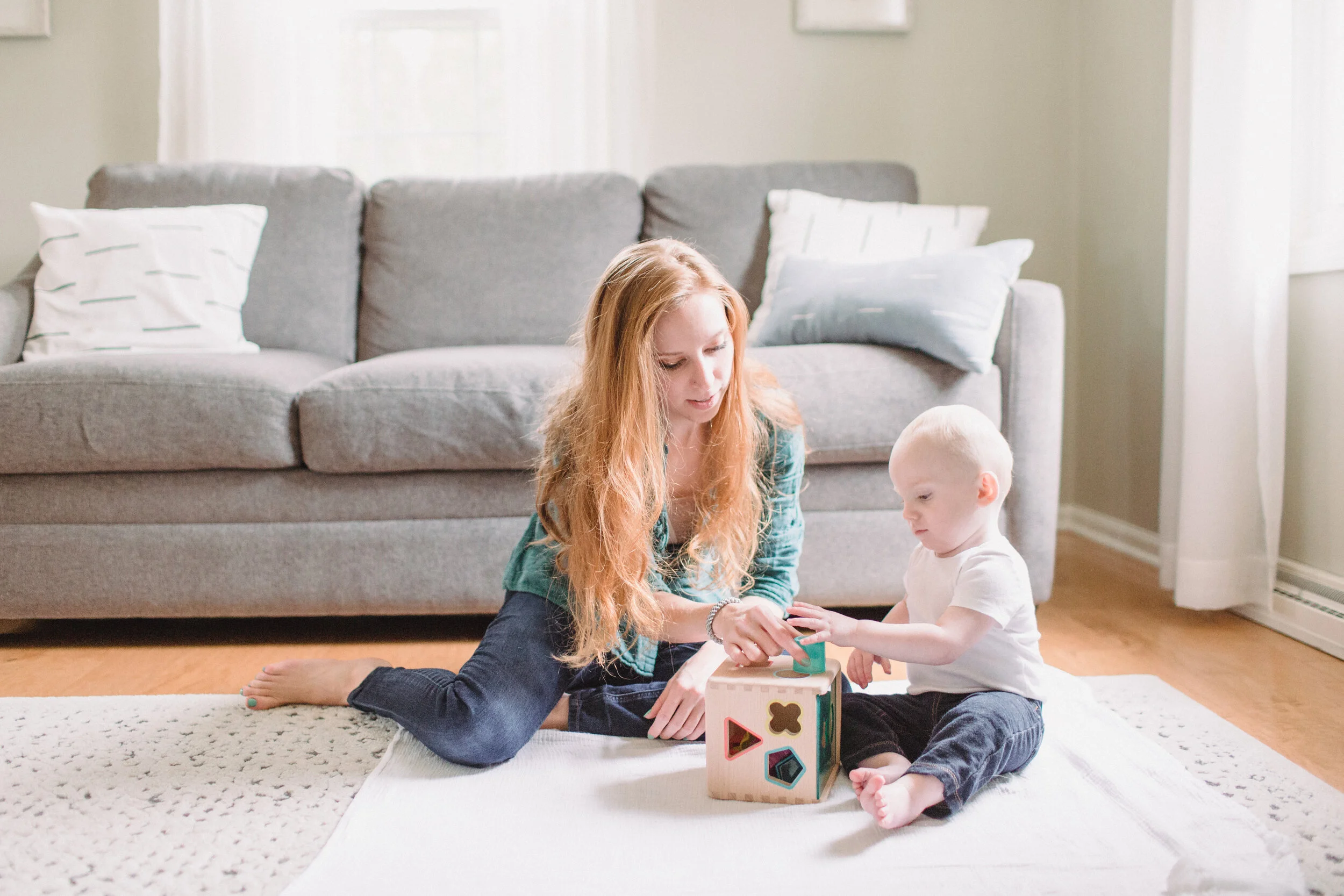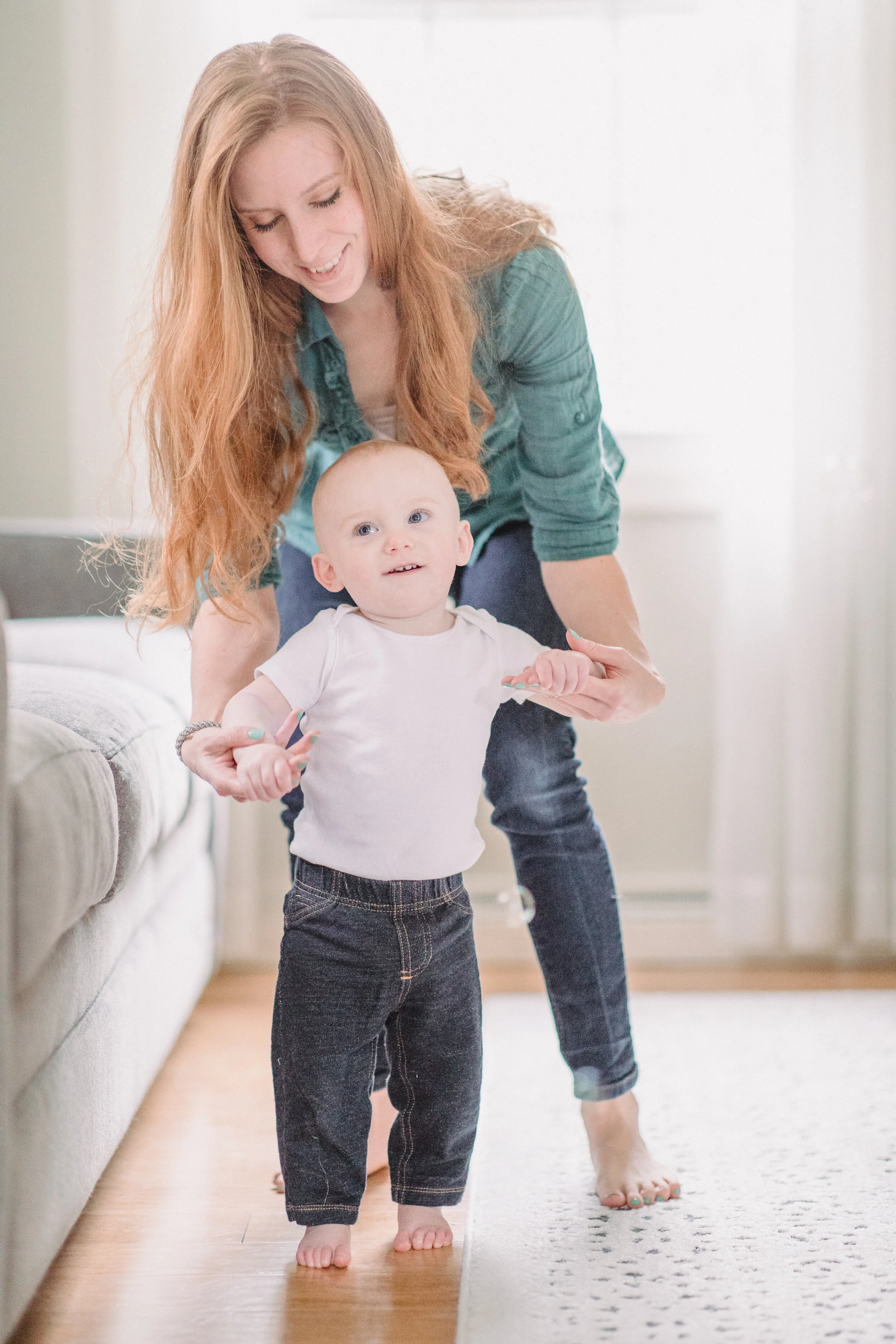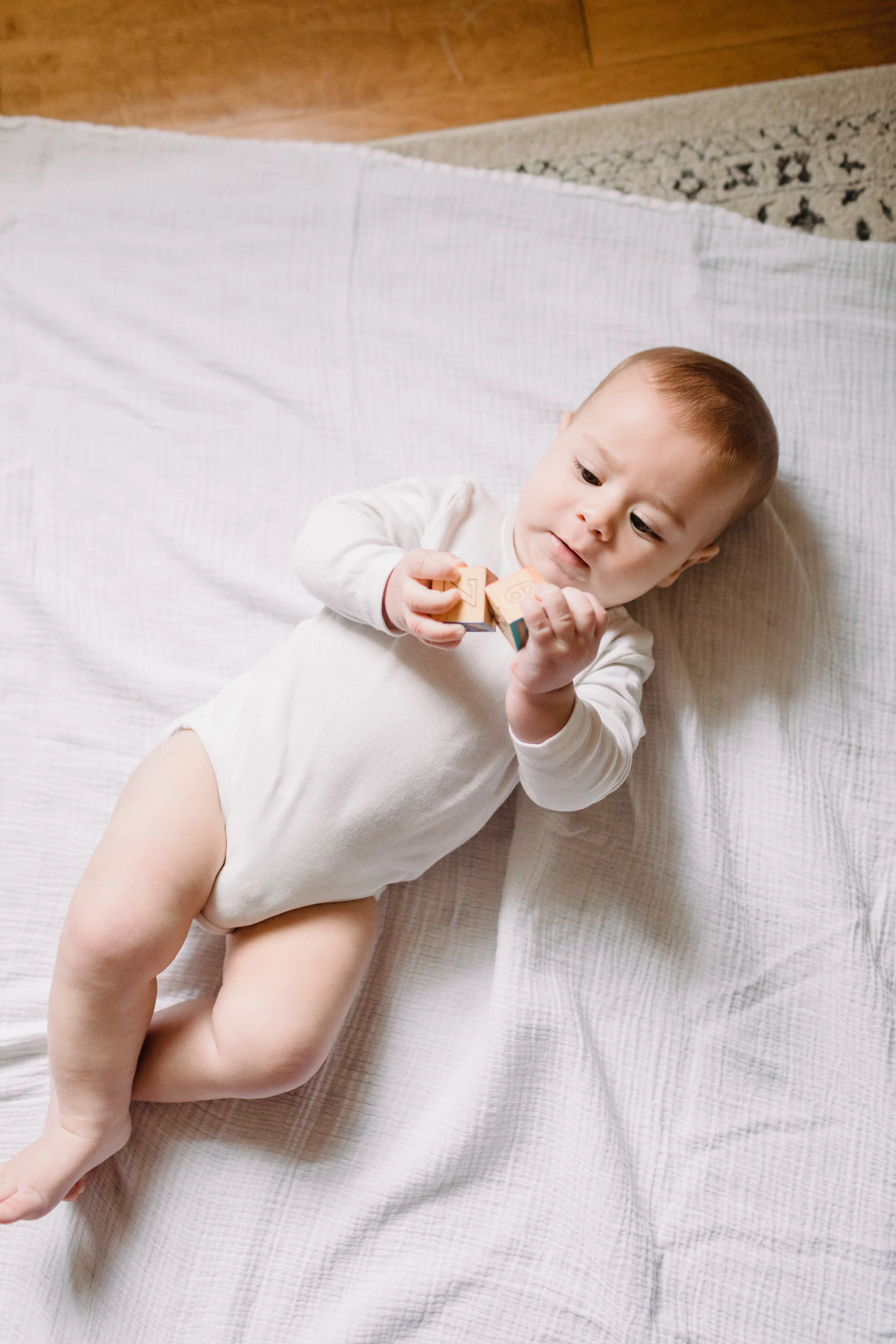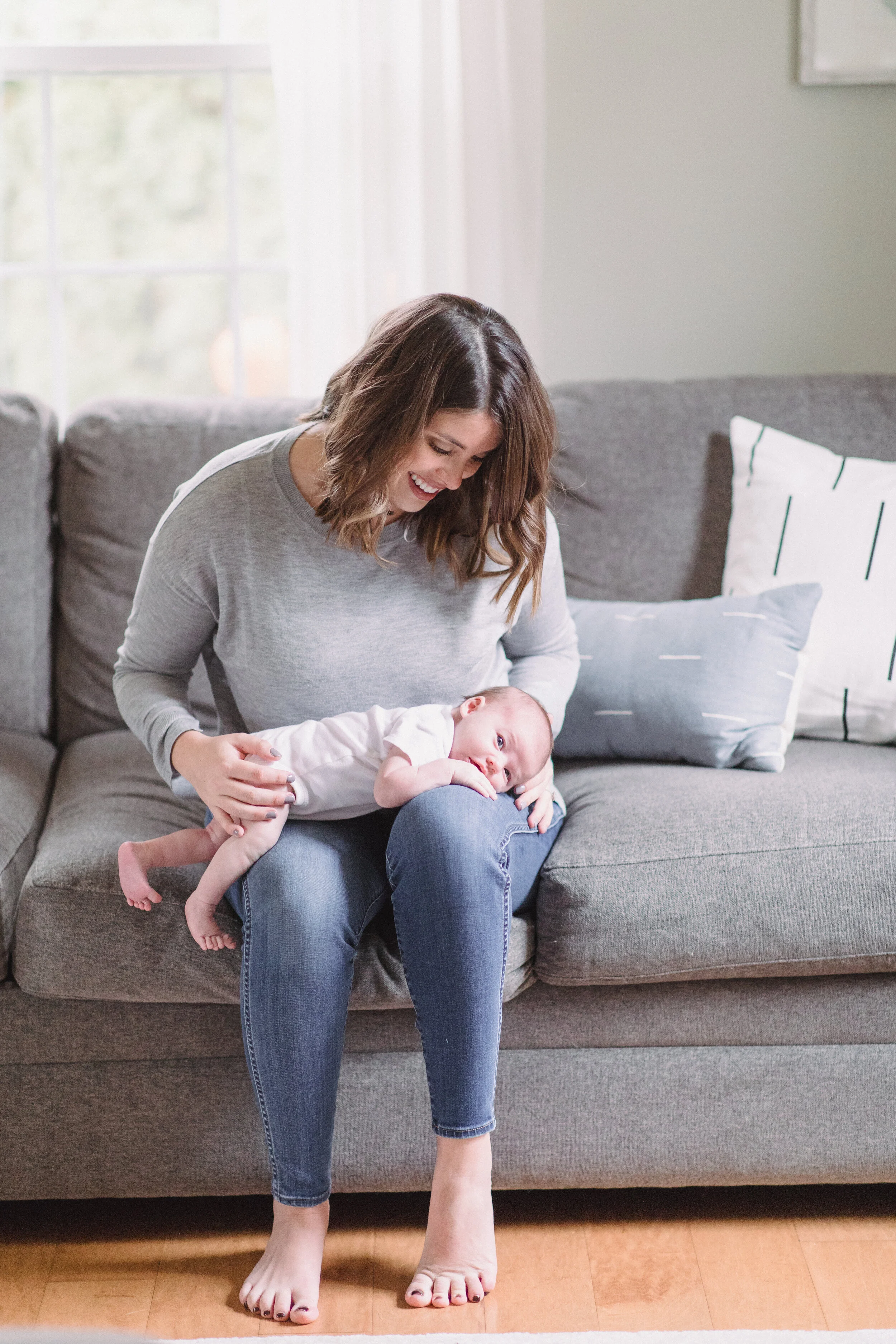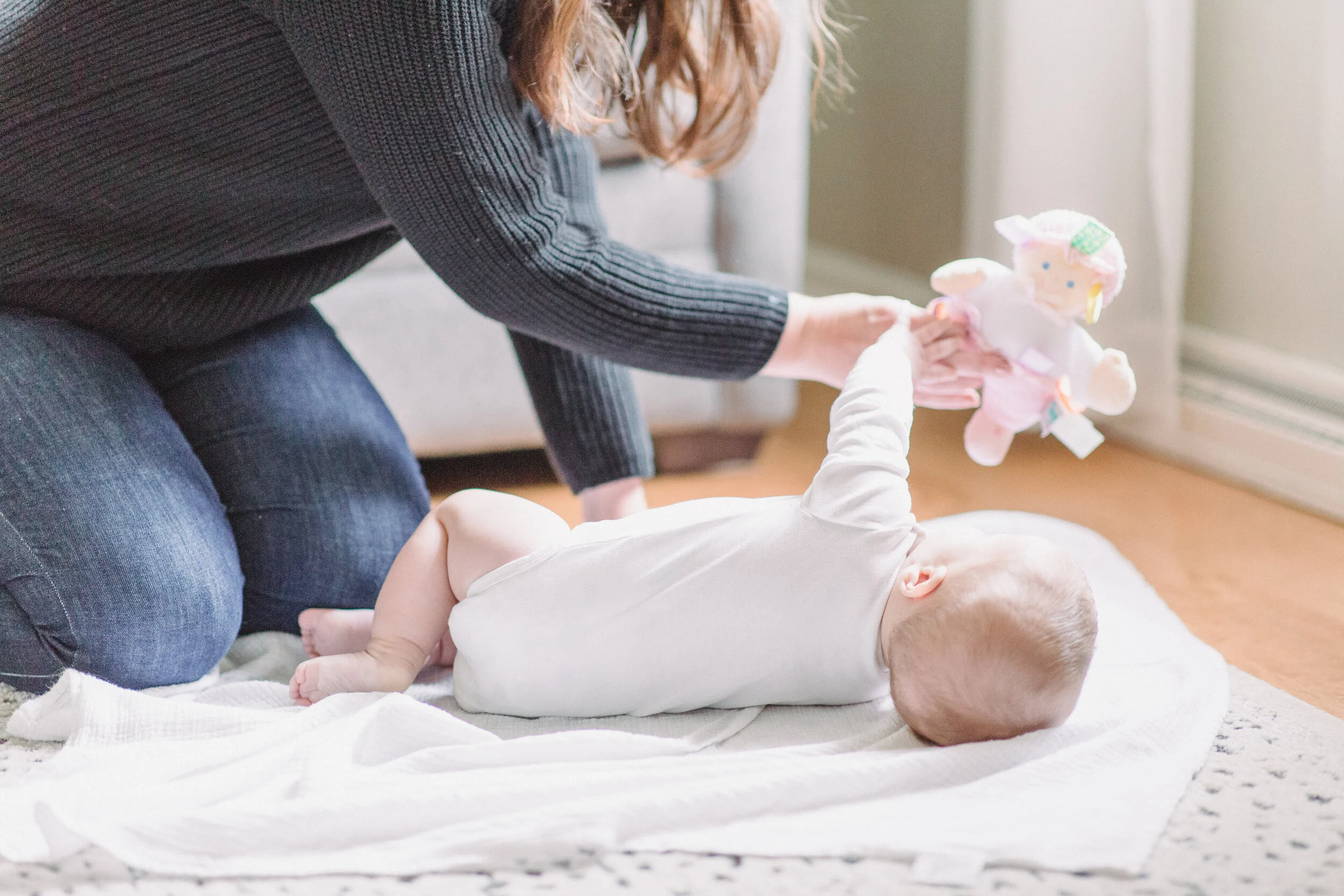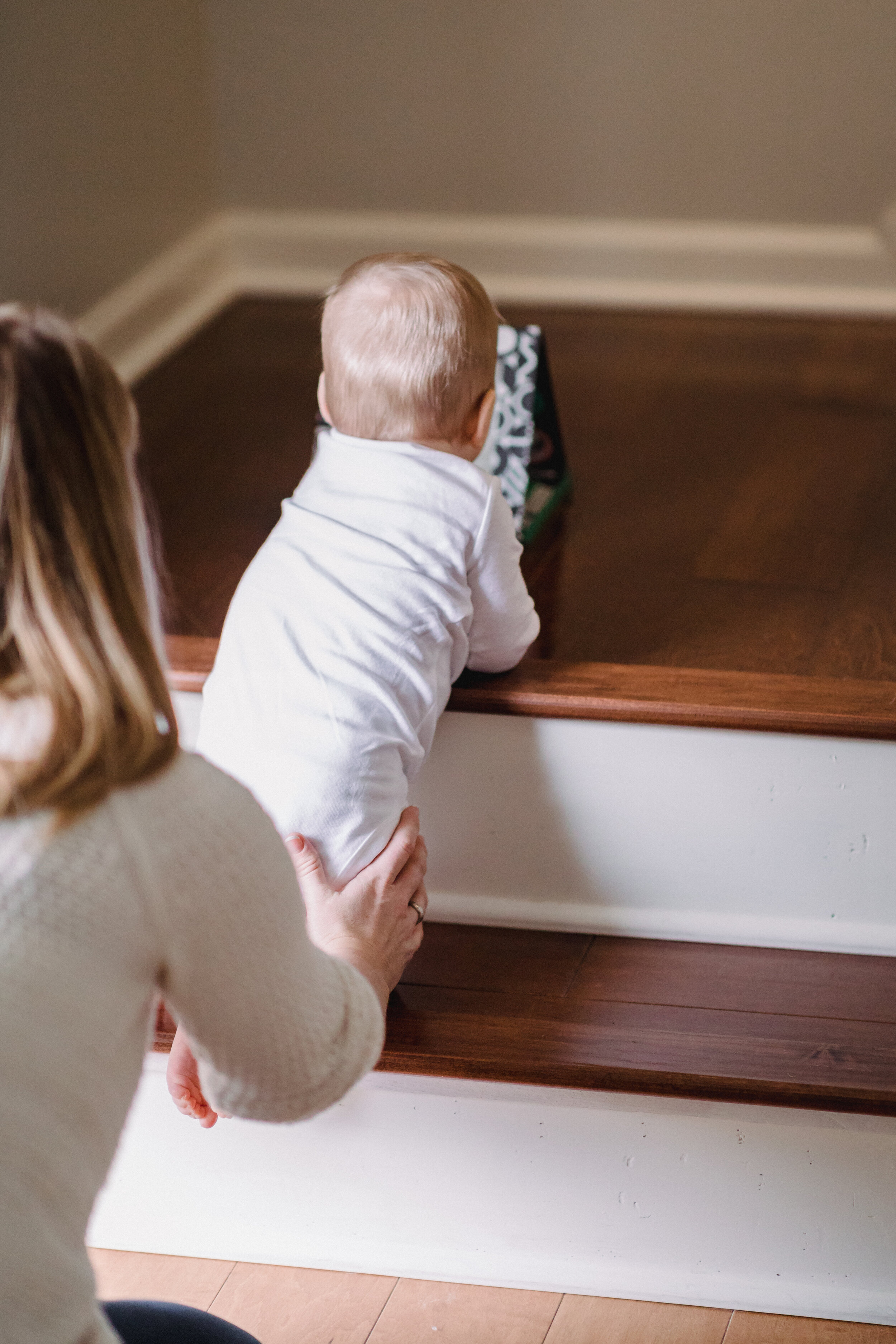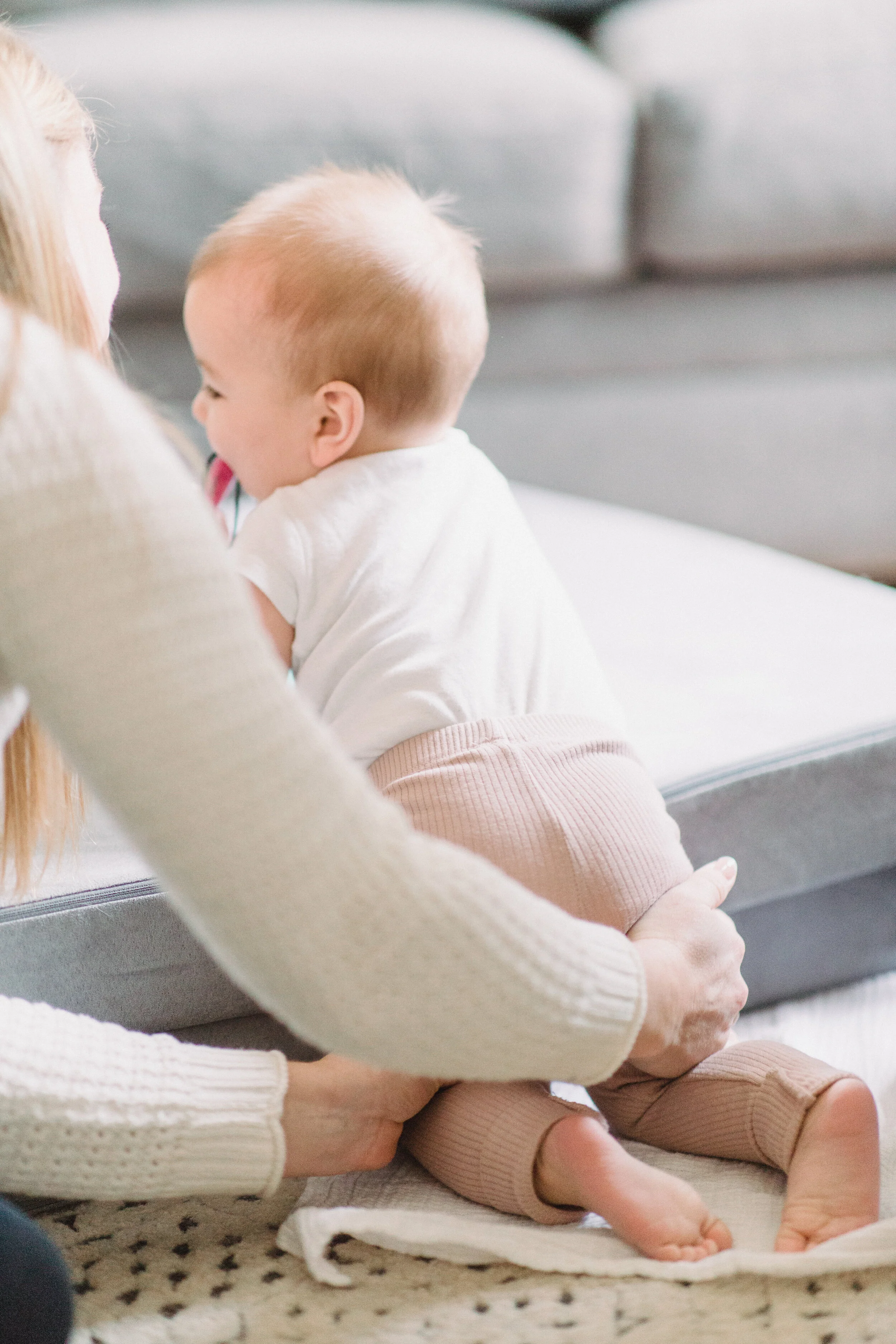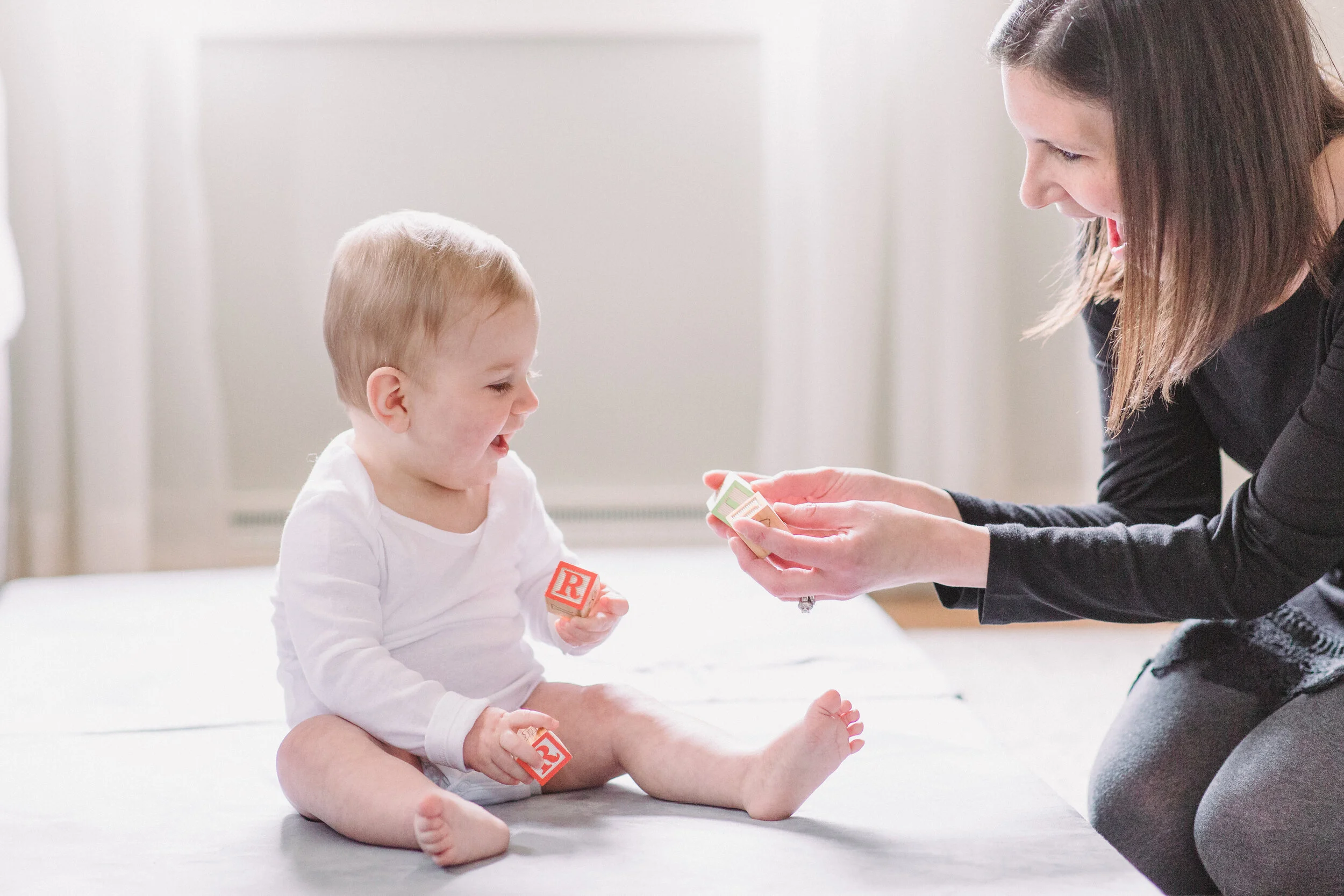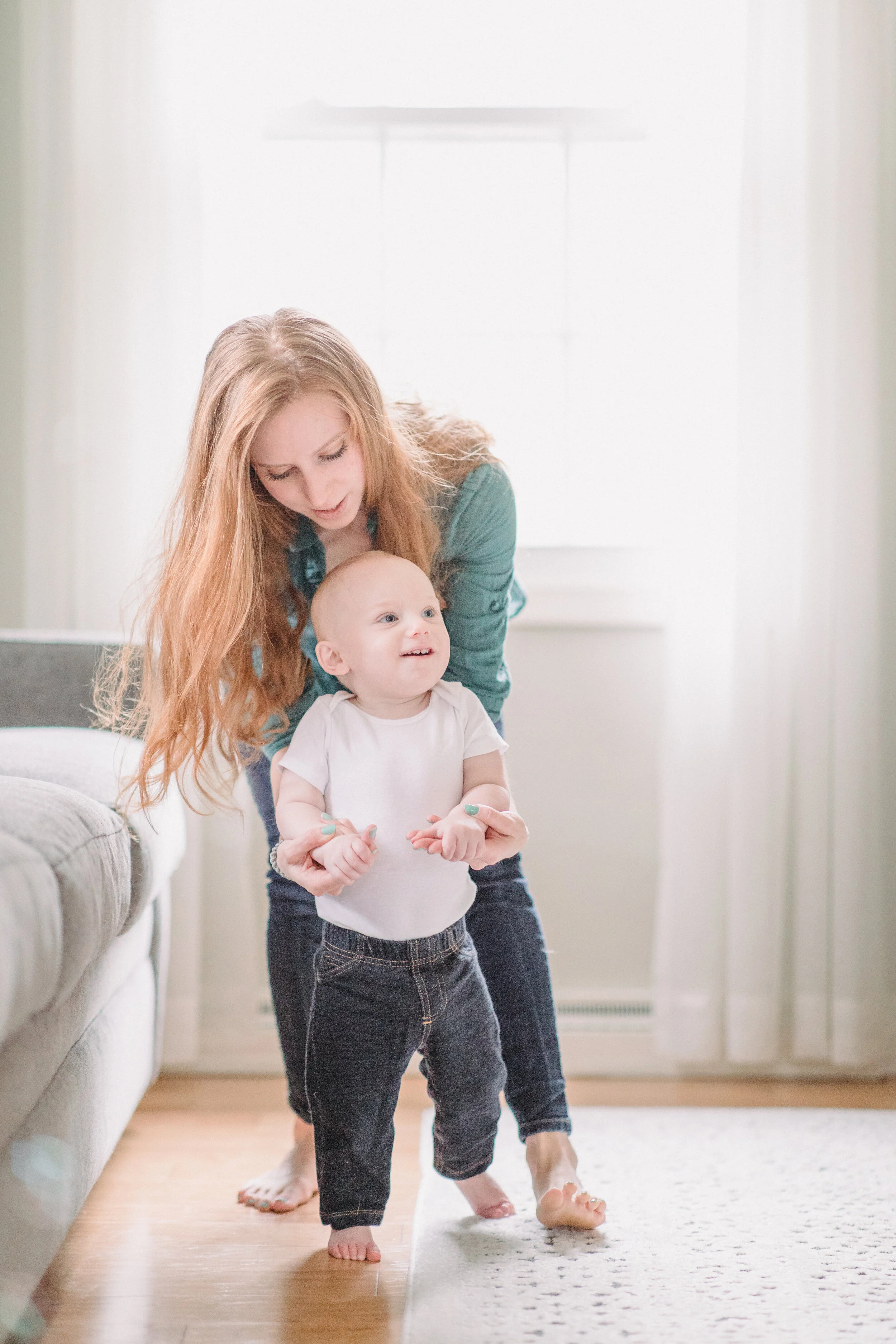New physical clinic space is opening in Snohomish, WA. Current clients will continue to be seen in their homes and may transition to the clinic space in early summer.
Bree is continuing to offer in-home, virtual, and online courses as the clinic gets up and running.
Book today!
Favorite Products- Feeding
Floor Play Ideas for Every Stage of Development
Parents often hear that tummy time is important for babies but research supports that floor play is actually very important for every stage of baby’s motor development. That’s why we’re passionate about our “The Floor Builds the Core™” concept which states that a baby gets stronger and masters motor skills by learning how to move in and out of positions while they’re on the floor.
More info here on the movement science behind our “The Floor Builds the Core™” framework.
Play to Prepare for Walking
Babies need to progress through motor skills to master them and then build on them. Strength and endurance are gained through play in preparatory positions like kneeling, squatting, cruising, or walking behind a push toy. Most parents are dying to celebrate first steps, but don’t rush it! Here are some fun and easy ways to play to strengthen baby for first steps.
Reading with a Baby - Play Ideas for the First Year
Children who are read to regularly at home throughout early childhood will be exposed to exponentially more words than their peers who are not regularly read to. By the time they reach kindergarten, children will have heard 290,000 more words if read 1 book each day and 1.4 million more words if read 5 books each day (Logan, et al., 2019). Here you’ll find ideas on HOW TO read with a baby from birth through the first year.
Play Activities for Baby Hands
Did you know that hand skills are developed through crawling? It's true! Crawling develops the upper body and the arches of the hands which later helps with holding a fork, writing, tying shoes and lots more! Here, you’ll find simple play ideas to help develop baby hands from birth through the first year.
Baby's Hands - The Foundation to Dexterity
The Power of Baby Sign Language - A Book Review
Our friend, Elise Tate, just released her first book called Sign Me Up for a Happy Home. It’s filled with 15 baby signs and is full of great illustrations and written examples of how to do and remember each sign. Check it out here!
New Parent Hacks - How to Avoid Baby Containers and Still Get Through Your Day
So you read our post on avoiding baby containers and now you’re wondering how you’ll get through a busy day while still sneaking in a shower or making dinner without using all of the baby contraptions like a swing, bouncer, exersauser, jumper, or Bumbo? We’ve got you covered!
Baby Containers - How and Why to Avoid Them
Baby gear/contraptions/containers all refer to a piece of equipment that puts a baby into a position and keeps them there. Gear like a swing, bouncer, exersaucer, jumper, or Bumbo. Most of this gear puts baby into a position they are not yet ready to maintain on their own and can not get into/out of on their own - meaning it’s not developmentally appropriate for them. Containers prevent a baby from moving in and out of positions naturally! Developmentally speaking, the devices pictured above, generally put babies into positions their little bodies are not yet ready for and they prevent baby from freely moving.
Sitting - How to Teach a Baby to Sit
How to Choose a High Chair
Tips for choosing the best highchair positioning for your baby. Optimal positioning for feeding can help baby feel more secure and set you both up for mealtime success. Browse our favorite highchairs or get ideas for how to modify your current highchair to best fit your baby’s needs before starting solids.
Favorite Products- High Chairs
Tummy Time Positions for Newborns
Many new parents have asked us, “What do I do with a newborn all day?” Our answer: Take that nap and when you wake up, spend time holding, snuggling, and getting to know your baby in those early days, and from day one, get baby on his/her belly regularly! All future movements your baby will learn start in tummy time.
How to Encourage Your Baby to Roll
Rolling is one of baby’s first forms of mobility. It allows baby to start the process of seeing something and actually going to get and explore it. Rolling is a complicated movement that requires the two sides of the body to do opposite movements. This is important for the brain- body connection (i.e., how the body learns to respond appropriately when the brain says “reach”), to build neuronal maps (i.e., how baby will learn to move in 3D space), to strengthen bilateral coordination skills (i.e., to use both sides of the body), and is preparing baby to develop more complex movements.
How to Encourage Your Baby to Crawl
Crawling is extremely important for hand skills later in life. As baby puts weight through the shoulders, forearms, wrists, hands and fingers, he/she is developing strength, dexterity, hand-eye coordination, and sensory integration that will be used later in life to support many skills, including a functional grip when holding a fork at mealtime, handwriting, and zipping a coat.
What to do if Your Baby Skipped Crawling
You probably know someone or have at least heard stories of people who skipped crawling, went straight to walking, and “turned out just fine.” We’ve met these people too! If your baby skips crawling, he/she WILL probably be just fine, BUT we are here to make a case for not “skipping” this milestone and circling back to it if your baby did not, or only briefly crawled on hands and knees before walking.
How to Encourage Your Baby's Communication
Although you may jump right to thinking about baby’s first word when you think of communication development in the first year, there is so much that needs to develop in baby’s brain before we can expect to hear that first precious “mama” or “dada.” We use the term communication to encompass many aspects of speech and language development, including vocabulary (i.e., how many words a child says), articulation (i.e., how words are formed in the mouth), language expression (i.e., what a child says) and comprehension (i.e., what a child understands), gesture use (e.g., waving), and social skills (e.g., eye contact, turn-taking).
How to Encourage Your Baby to Take First Steps
One of my most commonly asked questions from parents is, “How do I teach my baby to walk? He seems close!” Without seeing your child, it’s hard to say exactly why he isn’t walking yet, but it is most often because he needs to do a little more strength and endurance work before he is really ready to take those first dynamic steps unsupported- it is a ton of work!
When Should My Baby Start Solids?
You’ve finally gotten the hang of feeding your newborn, first around the clock, and now at slightly longer and more predictable intervals (and hopefully not at 4am!). As with everything else in babyhood, as soon as you’re in a good routine, it’s time to start thinking about what comes next. Starting solids can be an exciting but daunting task. Considering all of the options and opinions surrounding when and how to feed your baby can lead to more questions than answers.
When to start
The American Academy of Pediatrics (AAP) recommends that babies be exclusively breastfed, with expressed breast milk or iron fortified formula as acceptable alternative options, for the first six months of life. But, you shouldn’t just look at the calendar to tell you if it’s time to start. Babies need to have mastered several gross motor and oral-motor skills prior to being introduced to solids to improve safety (i.e., reduce risk of choking) and overall tolerance of those first meals.
Why wait until at least 6 months?
Babies are born with several reflexes that help them feed and keep them safe from choking immediately at birth. One of those reflexes is the tongue-thrust reflex, which causes baby to forcefully push his/her tongue out of the mouth when something other than breast or bottle touches the lips or tongue. This means that anything that enters baby’s mouth in the front ⅓-½ will be “thrusted” or pushed out of the mouth, too. This reflex is protective to help baby avoid choking in the first months of life.
Around 4 months of age, baby will begin to integrate this tongue-thrust and reflexive sucking to develop more complex and intentional mouth movements by bringing hands and toys to his/her mouth for oral exploration. These early mouthing experiences lay the foundation for later jaw, lip, and tongue movements necessary for safe transition to solid foods. Trying to start solids before these reflexes have integrated can easily lead to baby pushing the food out of his/her mouth, fussing, or gagging.
Eating requires the body to be strong and well supported in order to support the mouth and neck for a safe swallow. Safe introduction of solids requires that the muscles of the mouth have matured to support skills beyond the sucking/suckling of infancy. Before starting solids, baby should have mastered the following gross motor and oral-motor skills:
Prerequisite gross motor skills:
Demonstrate the ability to cough and clear the airway
Hold his/her head up for long periods of time and look around the room (i.e., have good head control)
Sit unsupported briefly on the floor (i.e., have developed postural control/strength to maintain a safe position for swallowing)
Prerequisite oral-motor skills:
Bring hands and toys to mouth frequently
Move toys and fingers to the sides of the mouth (i.e., the area of the gums where molars will erupt) and chew up-and-down several times
Move tongue to both sides of the mouth to push against/explore toy while chewing
Open mouth wide in anticipation of a spoon or toy and close lips/jaw around the utensil to clear
How to set baby up for feeding success
Starting around 4-5 months, when baby starts showing interest in others eating and can sit comfortably in his/her highchair, I recommend starting to involve baby in family mealtime. Having regular opportunities to observe others and practice the prerequisite skills needed to start solids will help ease the transition once baby reaches 6 months old and you’re ready to start feeding.
Bring baby to the table frequently to get used to sitting in the high chair
Provide safe chewing toys for oral exploration. We recommend toys that are large enough not to be a choking hazard, but that have areas small enough for your baby to bring the toy to the molar area for chewing and tongue lateralization practice. Here are some of our favorites: *
Reusable soft silicone smoothie/water bottle straws: cut down to approx 4 inches or tie into a knot to shorten for baby to better be able to manipulate
Freeze small amounts of breast milk or formula in an ice cube tray and place into a silicone feeder (like in the photo below), help baby bring to side of the mouth for chewing and not just suckling in the front of the mouth.
Dip the tools above in expressed breast milk or formula so baby gets practice chewing and swallowing small amounts of liquid
Talk about the foods you’re eating and model eating to your baby
Start prepping foods and freezing now, you’ll thank yourself later!
*We participate in the Amazon Affiliates Program. If you click on a link above and buy the product , we earn a small referral fee without any additional cost to you. These products are genuinely our favorites as therapists and moms. We won’t recommend anything we haven’t tried or don’t fully stand behind.
Some babies may not be ready for solids right away when they turn 6 months old, and that is just fine too! Taking time to ensure that baby has mastered all of the skills above will mean that you are giving your baby the best and safest start to his/her feeding journey. Check back to this list every week or two, and feel confident that you are starting solids at the right time for your baby.
Use our milestone checklists to track your child’s skills and progress and always speak with your pediatrician if you are concerned about your child’s feeding skills. There are oral-motor and feeding delays and disorders that are unavoidable and require early detection and prompt intervention by a licensed SLP or OT trained in feeding.
More to come on WHAT to feed your baby starting at 6 months including links to some of our favorite dietitians who have extensive training and wonderful resources already compiled to answer more of your questions about starting solids.
Jaclyn
We’re Bree & Jaclyn
Pediatric therapists and moms with a mission to empower you with knowledge to encourage your baby’s development and continue confidently into your parenthood journey.
If you have any questions, please feel free to leave a comment below and we will get back to you. As always, the information we share is meant to provide general education and tips and is not intended as medical advice. If you have a specific question or concern about your child’s development, please speak directly to your child’s doctor or therapist.

